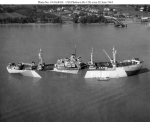
USS Guadalupe (AO-32), a Cimarron-class fleet replenishment oiler that served in the United States Navy, it was named for the Guadalupe River in Texas.

USS Hall (DD-583) was a Fletcher-class destroyer of the United States Navy. Hall entered service in 1943 and deployed to the Pacific theater. Following the war, the ship was placed in reserve until 1959, when she was sold to the Hellenic Navy and renamed Lonchi. The destroyer remained in service with the Hellenic Navy until 1990 and was scrapped in 1997.

USS Kaskaskia (AO-27) was a Cimarron-class fleet replenishment oiler serving in the United States Navy, named for the Kaskaskia River in Illinois.

USS Kankakee (AO-39) was a Kennebec-class fleet oiler of the United States Navy. The ship was built as SS Colina by Bethlehem Steel Co., Sparrows Point, Maryland, launched on 24 January 1942, sponsored by Mrs. D. A. Little, acquired for the Navy on 31 March through the Maritime Commission from her owner, Socony-Vacuum Oil Company, New York City, and commissioned as Kankakee at Norfolk, Virginia, on 4 May.

USS Patuxent (AO-44) was a Kennebec-class oiler in the United States Navy during World War II. She was the second U.S. Navy ship named for the Patuxent River in Maryland.

USS Suamico (AO-49) was the lead ship of her class of Type T2-SE-A1 fleet oilers of the United States Navy.
USS Saranac (AO-74), originally named the SS Cowpens, was a Type T2-SE-A1 Suamico-class fleet oiler of the United States Navy, and the fourth ship of the Navy to bear the name.

The USS Manatee (AO-58)—the second vessel of the United States Navy to bear the name—was a Cimarron-class fleet replenishment oiler named for a river in Florida. Cimarron-class oilers were named after American rivers in the southern United States.

USS Wesson (DE-184) was a Cannon-class destroyer escort built for the United States Navy during World War II. She served in the Pacific Ocean and provided escort service against submarine and air attack for Navy vessels and convoys. She returned home at war's end with a very respectable seven battle stars to her credit.

USS Lamons (DE-743) was a Cannon-class destroyer escortin service with the United States Navy from 1944 to 1946. She was sold for scrapping in 1973.

USS Marias (AO-57) was a Cimarron-class fleet oiler acquired by the U.S. Navy during World War II. She served her country primarily in the Pacific Ocean Theatre of Operations, and provided petroleum products where needed to combat ships. For performing this dangerous task, she was awarded eight battle stars during World War II, and one campaign star during the Vietnam War for her bravery in combat areas.

USS Sebec (AO-87) was a Escambia-class fleet oiler acquired by the United States Navy for use during World War II. She had the dangerous but necessary task of providing fuel to vessels in combat and non-combat areas primarily in the Pacific Ocean. For her valiant efforts, she received six battle stars during the war.
USS Tamalpais (AO-96) was a Escambia-class replenishment oiler acquired by the United States Navy for use during World War II. She had the dangerous but necessary task of providing fuel to vessels in combat and non-combat areas. She served in the Pacific Ocean Theatre of operations late in the war.

USS Maurice J. Manuel (DE-351) was a John C. Butler-class destroyer escort acquired by the U.S. Navy during World War II. The primary purpose of the destroyer escort was to escort and protect ships in convoy, in addition to other tasks as assigned, such as patrol or radar picket.

USS George E. Davis (DE-357) was a John C. Butler-class destroyer escort acquired by the U.S. Navy during World War II. The primary purpose of the destroyer escort was to escort and protect ships in convoy, in addition to other tasks as assigned, such as patrol or radar picket.

USS Formoe (DE-509) was a John C. Butler-class destroyer escort in service with the United States Navy from 1944 to 1946 and from 1951 to 1957. She was then transferred to Portugal, where she served as NRP Diogo-Cão (F-333) until 1968. She was scrapped in 1970.

USS Phobos (AK-129) was a Crater-class cargo ship commissioned by the U.S. Navy for service in World War II. She was responsible for delivering troops, goods and equipment to locations in the war zone.

USS Lamar (APA-47) was a Bayfield-class attack transport in service with the United States Navy from 1943 to 1946. She was sold into commercial service in 1948 and was scrapped in 1971.

USS Latimer (APA-152) was a Haskell-class attack transportin service with the United States Navy from 1944 to 1947 and from 1950 to 1956. She was scrapped in 1972.

USS Audrain (APA-59) was a Gilliam-class attack transport that served with the US Navy during World War II.




















